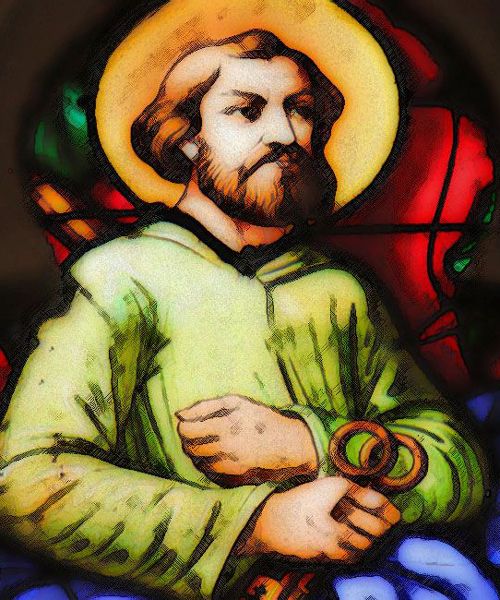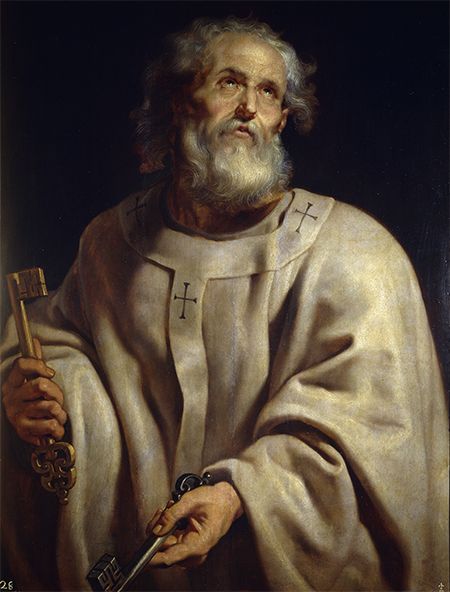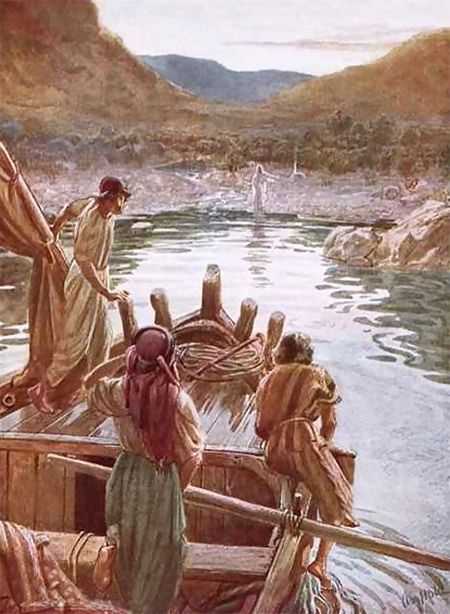
Peter and the Rock
How is it possible for a church to teach doctrines about Mary that have no support in the Bible? From the dogma of perpetual virginity, the Immaculate Conception, and the Assumption, many of these Catholic teachings don't have even a single reference from Scripture to support them. So why are they part of the Catholic tradition?
The answer, in part, is found in the interpretation of a passage in Matthew chapter 16 about the disciple Peter. Let's take a closer look.
Background of Papal Authority
The church of Rome teaches that before Jesus ascended into heaven, Christ appointed Peter as His vicar—a divinely chosen substitute leader to serve in Jesus' place here on earth. Then, after Peter died, another successor is said to have taken his place. This process continued, year after year, without interruption, even until the present-day pope. The current church leader, it is claimed, is not only Christ's representative on earth, but he also has the power to explain and define both the written Word of God and the oral traditions passed down from generation to generation in the Catholic faith.
From his place of authority, the pope chairs church councils, writes encyclicals and pastoral letters, and defines the beliefs of the Roman Catholic Church. Even though many of the things he states are not explicitly found in the Bible, they are to be accepted and believed by the faithful because of the special position the pope holds in teaching religious doctrine.
Moreover, when the pope speaks 'ex cathedra' from his papal throne, his declarations are considered infallible. His teachings are regarded as equal with the teachings of Christ and cannot be revised, changed, or abolished. It is from the belief in this papal primacy that many teachings of the church have been passed down without the smallest thread of evidence from the Bible to support them.
The four primary church teachings on Mary (called the four dogmas of Mariology) have been established through this papal office. The doctrines are not founded on the Scriptures, but are a result of the belief in apostolic succession and in the infallible authority of the teaching office of the Catholic Church. To support the claim that the ministry of the church is held through a series of bishops, the church points to a conversation that took place between Christ and Peter.
The Pebble and the Rock
Perhaps the most important text used from the Bible to support the teaching of apostolic succession and the establishment of the papal office is found in Matthew 16. Jesus was in Caesarea Philippi, outside the northern border of Israel, when He asked His disciples two important questions. First, 'Who do men say that I, the Son of Man, am?' (v. 13). The disciples responded, 'Some say John the Baptist, some Elijah, and others Jeremiah or one of the prophets' (v. 14).
Christ was not really interested in what others thought of Him. He really wanted to know what His disciples thought about Him. So He asked, 'But who do you say that I am?' (v. 15). Peter, who appeared to be a spokesman for the disciples, answered, 'You are the Christ [the Messiah], the Son of the living God' (v. 16).
Peter did not fully understand what he was saying and his comments didn't come from within his own mind, for 'Jesus answered and said to him, 'Blessed are you, Simon Bar-Jonah, for flesh and blood has not revealed this to you, but My Father who is in heaven'' (v. 17, emphasis added).
Next come two verses that have been interpreted to support what is known as the 'primacy of Peter' or the 'Petrine primacy,' elevating him to a position of preeminence among the twelve disciples. Jesus continued, 'I also say to you that you are Peter, and on this rock I will build My church, and the gates of Hades shall not prevail against it' (v. 18).
The Greek word for 'Peter' used in this verse is petros and means a pebble or small stone. It is a word in the masculine gender (an important point you will see in a moment). The same word is used in Jesus' parable of the sower when He described how some seed fell among 'stony (petrodes) places' (Matthew 13:5). Christ was acknowledging that Peter was a small pebble.
So what did Jesus mean when He went on to say 'and on this rock I will build My church, and the gates of Hades shall not prevail against it'? (Matthew 16:18). What does 'this rock' refer to? Some say Peter, some say the confession of Peter, and some say Christ.
The Greek actually says, 'And on this, the Rock, I will build My church.' The word for rock here is the Greek word petra and speaks of a massive, immovable rock. Unlike petros (in the masculine form), a small pebble that is easily moved, the word petra is in the feminine gender, so it cannot refer to Peter as the genders must agree in such writing.
Christ was basically saying, 'You are Peter, a small movable pebble. But upon the Rock, a massive and immovable stone, I will build My church.'
Identifying the Rock
Who is the rock (petra) to which Christ is speaking in Matthew 16? Though the Catholic Church teaches it refers to Peter, there is not unanimity within the church on this point. For instance,
- Origen, one of the early church fathers, taught that the rock speaks of every disciple of Christ.
- Tertullian said the entire church body of believers is meant to be the rock.
- Cyprian defined the rock as the entire body of bishops.
- Chrysostom identified the rock as Peter's confession, not Peter.
- Augustine, one of the greatest theologians of the Catholic faith, leaves it for his readers to decide between Christ or Peter.
Not until the fifth century did a pope, Leo I, interpret Peter as 'this rock.'
If you study the Bible, you will search in vain for any reference to a human being represented as this spiritual rock. In fact, in Hebrew culture, it would have been considered blasphemy to speak of anyone other than God as the Rock. Notice, 'For I proclaim the name of the Lord: ascribe greatness to our God. He is the Rock, His work is perfect; for all His ways are justice, a God of truth and without injustice; righteous and upright is He' (Deuteronomy 32:3, 4). (See also verses 13, 15, 18, 30, 31, and 37.)
The New Testament affirms this idea. Paul explained regarding the Israelites, 'All ate the same spiritual food, and all drank the same spiritual drink. For they drank of that spiritual Rock (petra) that followed them, and that Rock (petra) was Christ' (1 Corinthians 10:3, 4).
Peter himself understood who the Rock represented. When the apostle was arrested and stood before the Sanhedrin, he paraphrased from Psalm 118:22, speaking of Christ, said, 'This is the 'stone which was rejected by you builders, which has become the chief cornerstone'' (Acts 4:11). The Greek word lithos (synonymous with petra) was used in this instance. You can see in 1 Peter 2:8 that lithos and petra are used interchangeably.
Some people ask, 'Why did Jesus say, 'Upon this rock' instead of 'Upon Myself'?' Christ often used idioms—metaphors often found in the Old Testament—to describe Himself. For example, in Matthew 21:42, Jesus quoted Psalm 118:22, 23 (the same passage quoted by Peter before the Sanhedrin), speaking of Himself as the 'chief cornerstone.' He then states, 'Whoever falls on this stone will be broken; but on whomever it falls, it will grind him to powder' (Matthew 21:44). Christ clearly identifies Himself with the symbol of a rock.
In another example, Jesus once said to the Jews, 'Destroy this temple, and in three days I will raise it up' (John 2:19, emphasis added). When the Jews became confused about Jesus' use of an idiom, John explained in verse 21, 'He was speaking of the temple of His body.'
Built on the Rock
What does it mean that the church is built upon the Rock of Christ? If Jesus is in heaven, in what sense is the church built on Him? Paul provides us with an answer found in his letter to the church in Ephesus. He wrote to the believers:
'Now, therefore, you are no longer strangers and foreigners, but fellow citizens with the saints and members of the household of God, having been built on the foundation of the apostles and prophets, Jesus Christ Himself being the chief cornerstone, in whom the whole building, being fitted together, grows into a holy temple in the Lord, in whom you also are being built together for a dwelling place of God in the Spirit' (Ephesians 2:19–22).
The 'foundation of the apostles and prophets' is a reference to the Old Testament and 'the apostles' speaks of the New Testament. The center of the Bible is Jesus, the Rock, on whom the church is built.
At the end of Christ's sermon on the mount, we find the same terminology used to indicate that Jesus and His words constitute the rock upon which the church is built. Christ said:
'Therefore whoever hears these sayings of Mine, and does them, I will liken him to a wise man who built his house on the rock: and the rain descended, the floods came, and the winds blew and beat on that house; and it did not fall, for it was founded on the rock' (Matthew 7:24, 25).
To build upon the rock means that we, as individual believers who make up the church, build our lives on the sayings of Christ, which are found written in the Word of God. The Bible is a revelation of Jesus Christ and only upon the firm foundation of His Word will the church withstand the storms of this world.
The Gates of Death

Christ also said to Peter, in Matthew 16, 'And on this rock I will build My church, and the gates of Hades shall not prevail against it' (v. 18). The illustration we just looked at, found in Matthew 7, spoke of rains descending, floods coming, and winds blowing and beating 'on that house; and it did not fall.' There appears to be a strong connection between these two passages.
To understand Christ's use of the word 'Hades' in Matthew 16, let's make sure we properly interpret this often misunderstood term. The word actually means 'the grave' and 'death.' Notice how Paul uses Hades and death synonymously when he wrote, 'O Death, where is your sting? O Hades, where is your victory?' (1 Corinthians 15:55). The same parallelism is seen in the Old Testament where Sheol (the Hebrew equivalent for Hades) is used. Hosea wrote, 'I will ransom them from the power of the grave (Sheol); I will redeem them from death. O Death, I will be your plagues! O Grave (Sheol), I will be your destruction!' (Hosea 13:14).
Sheol and Hades refer to the grave, the place of death. So why does Jesus say 'the gates of Hades will not prevail against it'? It is because people believed that death was like a prison into which you were locked up for eternity. Notice how David explained this: 'Have mercy on me, O Lord! Consider my trouble from those who hate me, You who lift me up from the gates of death' (Psalm 9:13, emphasis added).
Immediately after Jesus' conversation with Peter, Matthew records how 'Jesus began to show to His disciples that He must go to Jerusalem, and suffer many things from the elders and chief priests and scribes, and be killed, and be raised the third day' (Matthew 16:21). He clearly told His followers that He would die and be raised the third day.
But they missed Christ's words about the resurrection and focused only on the grave and death. This so upset Peter, the disciple who had just affirmed Jesus' divinity, that Matthew wrote, 'Peter took Him aside and began to rebuke Him, saying, 'Far be it from You, Lord; this shall not happen to You!'' (v. 22).
How did Christ respond to Peter—the one who supposedly was the first pope? He says, 'Get behind Me, Satan! You are an offense to Me, for you are not mindful of the things of God, but the things of men' (v. 23). Jesus was trying to teach His disciples that He would die, but that the gates of death would not prevail against Him, nor against the church that would be built upon Him and His words.
Keys to the Kingdom
In Matthew 16, Christ also said to Peter, 'I will give you the keys of the kingdom of heaven, and whatever you bind on earth will be bound in heaven, and whatever you loose on earth will be loosed in heaven' (v. 19). What are the 'keys of the kingdom of heaven' that Jesus gave to Peter?
In the previous article , you learned how Christ warned the multitudes about the scribes and Pharisees who 'sit in Moses' seat' (Matthew 23:1). These religious leaders believed that sitting in Moses' 'seat' (in Greek, kathedra) gave them authority to define what the Holy Scriptures meant. Of course, the very Bible they supposedly understood pointed to Jesus as the Messiah—but they rejected Him.
Instead of opening doors for people to the kingdom of heaven, they were shutting doors and locking them. Notice how pointedly Jesus said to the religious leaders who claimed to have power to open up the kingdom of heaven:
'But woe to you, scribes and Pharisees, hypocrites! For you shut up the kingdom of heaven against men; for you neither go in yourselves, nor do you allow those who are entering to go in' (Matthew 23:13).
The parallel passage in the Gospel of Luke reveals the 'key' to the kingdom. Jesus said, 'Woe to you lawyers! For you have taken away the key of knowledge. You did not enter in yourselves, and those who were entering in you hindered' (Luke 11:52, emphasis added). Not only were these leaders locking themselves out of the kingdom, but they were preventing others from entering.
The Bible defines the knowledge that is central in heaven's eyes. When Zacharias prophesied about his son, John the Baptist, he stated, 'And you, child, will be called the prophet of the Highest; for you will go before the face of the Lord to prepare His ways, to give knowledge of salvation to His people by the remission of their sins' (Luke 1:76, 77, emphasis added). The knowledge of salvation opens the doors to the kingdom of heaven.
The Pharisees denied the key of knowledge found in the Scriptures—a key that points to Christ. When Jesus indicted the religious leaders, He told them, 'You search the Scriptures, for in them you think you have eternal life; and these are they which testify of Me. But you are not willing to come to Me that you may have life' (John 5:39, 40). The Bible testifies that a knowledge of Christ is the key to eternal life and the way into the kingdom of heaven.
Binding and Loosing
Were the keys to the kingdom given only to Peter, as the Catholic Church teaches?
Notice what Jesus tells us about who binds things on earth and in heaven:
'If your brother sins against you, go and tell him his fault between you and him alone. If he hears you, you have gained your brother. But if he will not hear, take with you one or two more, that 'by the mouth of two or three witnesses every word may be established.' And if he refuses to hear them, tell it to the church. But if he refuses even to hear the church, let him be to you like a heathen and a tax collector. Assuredly, I say to you, whatever you bind on earth will be bound in heaven, and whatever you loose on earth will be loosed in heaven' (Matthew 18:15–18).
Jesus gave the right to open and close, bind and unbind, to all true disciples. The same expression is found in Matthew 16 when Jesus spoke to Peter, but in Matthew 18, it applies to the church—that is, all of God's people.
It is helpful to understand the tense of the verbs 'to bind' and 'to loose' in these passages. The verbs are perfect tense, which means they speak of a past action with repercussions in the present. So the passage more accurately should read, 'Whatever you bind on earth will have been bound in heaven. And whatever you loose on earth will have been loosed in heaven.'
The church may point people to Christ and the way of salvation, but it has no power to deliver salvation to individuals. When we preach the gospel and, through the Holy Spirit, bind people's hearts to truth, that act is based on what Christ has already done at the cross of Calvary. Our present day witness that leads others to salvation focuses on the past work of Jesus in dying for our sins.
There is power in preaching the gospel, in witnessing for Christ, and in sharing Bible truth. Such evangelism opens or closes hearts. When Moses 'preached' to Pharaoh, the ruler's heart became hard because of his choice to reject heaven's pleadings. Paul preached a powerful sermon to King Agrippa, which was meant to soften the ruler's heart. Paul wanted to unlock the kingdom of heaven to this man, but sadly, the king said to Paul, 'You almost persuade me to become a Christian' (Acts 26:28).
Do You Love Me?

Another way the Roman Catholic Church attempts to elevate the status of Peter is through a conversation after the resurrection between Jesus and the disciple who denied Christ during His trial. Three times Christ asked him, 'Do you love Me?' (John 21:15–17). Why did Jesus ask this of Peter three times?
If you look back at a conversation between Christ and Peter before the crucifixion, Peter told Jesus, 'I will lay down my life for Your sake' (John 13:37). Notice Christ's response: 'Will you lay down your life for My sake? Most assuredly, I say to you, the rooster shall not crow till you have denied Me three times' (v. 38).
Christ not only predicted that Peter would deny Him three times (John 18:15–27), but He later gave the disciple an opportunity to repent of these denials. Three times Peter denied Christ, and three times Christ affirmed Peter as His disciple and His role in the young church.
However, Peter did not see himself as the only shepherd of God's flock. He wrote, 'The elders who are among you I exhort, I who am a fellow elder and a witness of the sufferings of Christ' (1 Peter 5:1). Peter did not see himself elevated above other church leaders.
He continued, 'Shepherd the flock of God which is among you, serving as overseers' (1 Peter 5:2). Other church leaders were to be shepherds of God's flock. Then he adds, 'When the Chief Shepherd appears [Christ], you will receive the crown of glory that does not fade away' (v. 4). Peter clearly did not see himself as the head of the church, but himself pointed to Christ alone.
Summary
Peter was undoubtedly a great apostle who played an important role in the early church. He was a fallible follower of Christ who not only denied Jesus but argued with the other disciples about who would be first in the kingdom of heaven. If, in fact, Christ chose Peter to be first, the disciples would have had no need to argue over this position. Sadly, the gates of Hades also prevailed against Peter in the garden of Gethsemane and in the court of the high priest when he denied Jesus as his Lord three times.
Peter was not first among the disciples. Several passages list others first (John 1:44; Galatians 2:7; 1 Corinthians 1:12). In 1 Corinthians 9:5, Cephas (Peter) is listed last. Furthermore, Peter was not the first to reach the tomb of Christ after the resurrection, but Mary Magdalene (John 20:1). John even beat Peter to the tomb (v. 4). And in the first general council meeting of the early church, James presided, not Peter. (See Acts 15:13–21.)
The central focus of the church and the foundation on which it is built is not Peter, but Christ—the divine Savior who alone is the head of His church.
*This series of articles is based on messages by Pastor Stephen Bohr.
To find additional information on his ministry, please visit www.secretsunsealed.org. To purchase his full series on Mary, please click here.
